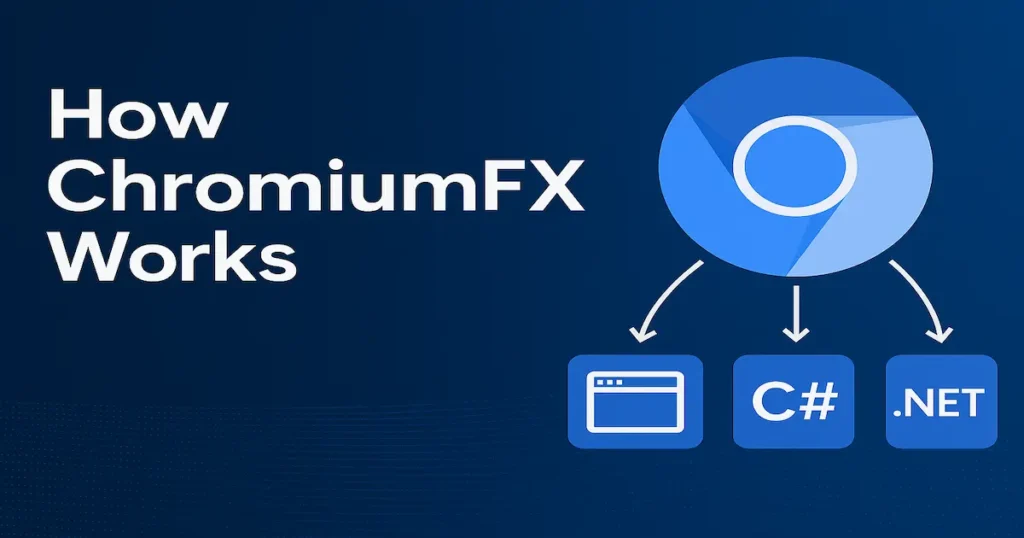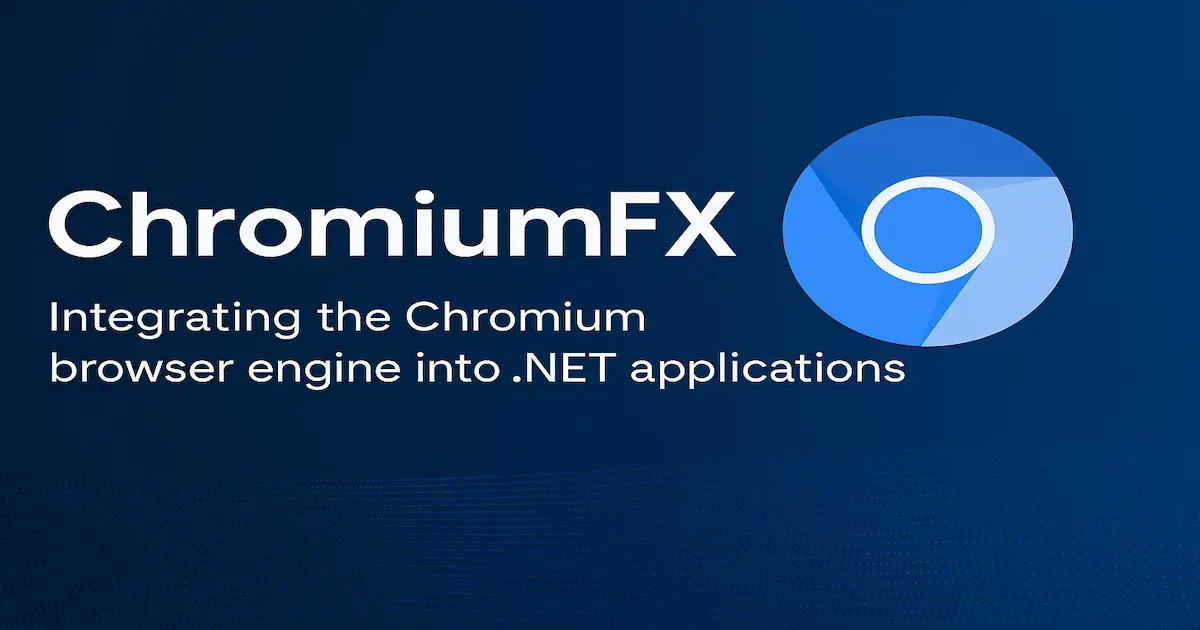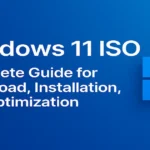ChromiumFX is a powerful tool that lets developers embed browser in desktop app using the Chromium engine. It’s especially useful for building modern hybrid desktop applications that need web content inside a Windows program.
With support for JavaScript in desktop apps, you can combine web features with native .NET functions easily. This guide will explore everything about ChromiumFX—from CEF .NET bindings to Chromium-based GUI development.
In this article, we’ll explain what ChromiumFX is, how it works, its use cases, setup steps, performance compared to other options like CefSharp, and how to build real-world applications with it.
What is ChromiumFX?
What is ChromiumFX? It is a lightweight open-source solution that allows developers to embed browser in desktop app environments using .NET browser integration.
Built on top of the Chromium Embedded Framework, ChromiumFX provides direct access to Chromium’s features through CEF .NET bindings.
This makes it easier to build hybrid desktop applications with HTML, CSS, and JavaScript frontends while retaining the power of native .NET backend logic.
Developers prefer ChromiumFX over bulkier alternatives like Electron because it delivers a minimal, efficient, and customizable approach.
For those needing Chromium for Windows applications or aiming to implement a custom browser in .NET, ChromiumFX has become an attractive option.
Many use it to build secure kiosk systems, dashboards, or Windows app with web interface functionalities that require seamless rendering of modern web content.
How ChromiumFX Works

At its core, ChromiumFX acts as a CEF wrapper for .NET. It provides access to the Chromium rendering engine, enabling developers to display and interact with web content within native desktop apps.
The main architectural flow consists of two parts: the CEF core (written in C++) and the .NET binding layer that bridges CEF with managed C# code.
This ChromiumFX architecture allows developers to load HTML files, render dynamic content, and even evaluate JavaScript in desktop apps.
What’s unique is the ability to handle JavaScript results in C# from ChromiumFX, which makes two-way communication smooth.
With this system, developers can create desktop apps with embedded web views that behave just like traditional browsers, but with added control and speed.
Key Features and Capabilities
ChromiumFX browser engine brings several powerful features for developers building CEF-based app development solutions. Here are the key capabilities:
| Feature | Description |
|---|---|
| Multi-Platform Support | Works well on Windows with options for Linux and macOS via CEF builds |
| HTML5 Rendering | Full support for modern web technologies, ideal for HTML5 UI in Windows app design |
| JavaScript Bridge | Call C# methods from JS and vice versa easily |
| Lightweight Integration | Less resource-intensive than Electron or CefSharp |
| Custom UI & Controls | Allows deep integration and Chromium-based GUI creation |
Because it is built on CEF, developers can leverage Chromium’s security, performance, and compatibility. With CEFGlue integration and options for standalone or embedded deployment, it suits diverse hybrid UI frameworks.
Installation and Setup
The ChromiumFX installation guide starts with downloading the correct build and referencing the CFX DLLs in your Visual Studio project.
You need to configure your project to copy native binaries and load them at runtime. This ensures your app initializes Chromium correctly without crashes.
Next, you must initialize the browser engine early in the program’s execution, then create an instance of the ChromiumWebBrowser control.
You can load local or remote URLs and use event handlers to manage interactions. The ChromiumFX project setup is straightforward once you understand how to manage native resources and dependencies.
ChromiumFX vs. Other Frameworks
ChromiumFX vs. Other Frameworks like Electron or ChromiumFX vs CefSharp is an ongoing debate. Electron is ideal for fully web-based UIs, but it’s heavy on resources and bundles an entire Node.js stack. CefSharp is a good middle-ground but can feel bloated and complex.
In contrast, ChromiumFX is highly customizable, less resource-intensive, and gives more control over browser behavior. It supports CEF binding libraries and suits scenarios where performance and precision matter more than ease of use.
Developers often choose ChromiumFX when they want to build hybrid .NET applications with a strong emphasis on control and performance.
| Feature | ChromiumFX | CefSharp | Electron |
| Resource Usage | Low | Medium | High |
| Integration Level | Deep .NET | Moderate | High JS |
| Flexibility | High | Medium | Low |
| Ecosystem | Smaller | Medium | Huge |
Use Cases and Real-World Applications
Use cases for ChromiumFX include enterprise apps, real-time dashboards, desktop web automation tools, and build kiosk browser systems. For instance, financial institutions use it to deliver interactive web dashboards inside secure .NET shells.
It is also used in healthcare tools that need to render medical forms inside a locked-down Chromium-based GUI.
A case study from a logistics firm shows how they replaced an outdated desktop UI with a web-driven interface rendered inside ChromiumFX. The new setup allowed for faster updates, better UI/UX, and native integration with backend APIs.
This is an example of ChromiumFX for Windows desktop helping businesses modernize legacy apps without rewriting everything.
Benefits and Limitations
The main benefits of ChromiumFX are performance, flexibility, and security. Its lightweight embedded browser model helps build faster apps that use fewer resources. Developers can fine-tune how and when browsers launch, how scripts execute, and how user input is handled.
But there are limitations. Debugging can be tricky because you’re working with native libraries and interop.
There’s also a learning curve when setting up CEFGlue integration or when managing dependencies across OS versions. Additionally, documentation isn’t as extensive as CefSharp or Electron.
Still, for those looking to render web content in .NET efficiently, ChromiumFX remains a solid choice.
Security and Best Practices
ChromiumFX and CEF explained brings key security concepts like sandboxing, origin control, and controlled JavaScript execution. You should always run your Chromium instances in sandbox mode, enable HTTPS-only content, and avoid loading remote scripts without validation.
Best practices include isolating browser instances per task, avoiding unnecessary plugins, and validating all JavaScript input.
When building open-source embedded browser tools or commercial products, consider containerization and regular updates to the Chromium core for patch management.
The Future of ChromiumFX
ChromiumFX maintenance status is currently community-driven, with contributors keeping the project aligned with CEF updates. However, it doesn’t move as fast as CefSharp or Electron. There are forks and GitHub repos with updated builds for newer CEF versions.
In the long term, ChromiumFX may evolve into a more modern toolset if more community developers join.
Its place in the ecosystem is as a reliable, flexible, lightweight browser integration layer for .NET browser integration scenarios, especially where developers want to avoid large runtimes and dependencies.
Conclusion
In closing, ChromiumFX is a compact, flexible, and powerful tool that allows developers to integrate Chromium into .NET desktop apps.
Whether you’re trying to build a kiosk, a secure app dashboard, or just need a browser in a .NET app, ChromiumFX gets the job done with minimal overhead. It supports hybrid desktop applications, runs JavaScript in desktop apps, and powers many niche business tools.
For developers in the USA seeking fast, flexible CEF-based app development, ChromiumFX remains one of the best .NET embedded browser options available today. As long as you’re comfortable managing native libraries and CEF dependencies, it will serve you well.
Stay with us to discover more articles on sahorizon.com.
Frequently Asked Question:
What is ChromiumFX and how is it different from other frameworks?
ChromiumFX is a .NET wrapper for CEF that allows embedding a browser in desktop apps. It offers better control and performance than heavier alternatives like Electron.
Is ChromiumFX free to use for commercial projects?
Yes, ChromiumFX is open-source and free under the BSD license. You can use it in both personal and commercial projects.
Can ChromiumFX run JavaScript inside the embedded browser?
Yes, ChromiumFX supports full JavaScript execution inside the embedded browser. It also allows communication between JavaScript and .NET code.
How does ChromiumFX compare with CefSharp?
ChromiumFX offers more control and lower overhead than CefSharp, making it ideal for advanced developers. CefSharp is easier to set up for beginners.
What platforms and frameworks support ChromiumFX?
ChromiumFX works on Windows and supports integration with .NET, WinForms, and WPF desktop applications.












